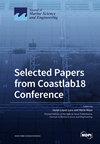Estimation of Source Range and Location Using Ship-Radiated Noise Measured by Two Vertical Line Arrays with a Feed-Forward Neural Network
IF 2.8
3区 地球科学
Q1 ENGINEERING, MARINE
引用次数: 0
Abstract
Machine learning-based source range estimation is a promising method for enhancing the performance of tracking both the dynamic and static positions of targets in the underwater acoustic environment using extensive training data. This study constructed a machine learning model for source range estimation using ship-radiated noise recorded by two vertical line arrays (VLAs) during the Shallow-water Acoustic Variability Experiment (SAVEX-15), employing the Sample Covariance Matrix (SCM) and the Generalized Cross Correlation (GCC) as input features. A feed-forward neural network (FNN) was used to train the model on the acoustic characteristics of the source at various distances, and the range estimation results indicated that the SCM outperformed the GCC with lower error rates. Additionally, array tilt correction using the array invariant-based method improved range estimation accuracy. The impact of the training data composition corresponding to the bottom depth variation between the source and receivers on range estimation performance was also discussed. Furthermore, the estimated ranges from the two VLA locations were applied to localization using trilateration. Our results confirm that the SCM is the more appropriate feature for the FNN-based source range estimation model compared with the GCC and imply that ocean environment variability should be considered in developing a general-purpose machine learning model for underwater acoustics.利用两个垂直线阵列测量的船舶辐射噪声和前馈神经网络估算声源范围和位置
基于机器学习的声源范围估计是一种很有前途的方法,可利用大量训练数据提高水下声学环境中目标动态和静态位置的跟踪性能。本研究利用浅水声学变异实验(SAVEX-15)期间两个垂直线阵列(VLA)记录的船舶辐射噪声构建了一个机器学习模型,将样本协方差矩阵(SCM)和广义交叉相关(GCC)作为输入特征,用于声源范围估计。使用前馈神经网络(FNN)对不同距离声源的声学特征进行模型训练,测距结果表明,SCM 的性能优于 GCC,误差率更低。此外,使用基于阵列不变量的方法进行阵列倾斜校正也提高了测距精度。此外,还讨论了与声源和接收器之间底部深度变化相对应的训练数据组成对测距估计性能的影响。此外,我们还将两个 VLA 位置的估计测距应用于使用三角测量法进行定位。我们的结果证实,与 GCC 相比,SCM 是基于 FNN 的声源范围估计模型更合适的特征,这意味着在开发水下声学通用机器学习模型时应考虑海洋环境的变化。
本文章由计算机程序翻译,如有差异,请以英文原文为准。
求助全文
约1分钟内获得全文
求助全文
来源期刊

Journal of Marine Science and Engineering
Engineering-Ocean Engineering
CiteScore
4.40
自引率
20.70%
发文量
1640
审稿时长
18.09 days
期刊介绍:
Journal of Marine Science and Engineering (JMSE; ISSN 2077-1312) is an international, peer-reviewed open access journal which provides an advanced forum for studies related to marine science and engineering. It publishes reviews, research papers and communications. Our aim is to encourage scientists to publish their experimental and theoretical results in as much detail as possible. There is no restriction on the length of the papers. The full experimental details must be provided so that the results can be reproduced. Electronic files and software regarding the full details of the calculation or experimental procedure, if unable to be published in a normal way, can be deposited as supplementary electronic material.
 求助内容:
求助内容: 应助结果提醒方式:
应助结果提醒方式:


